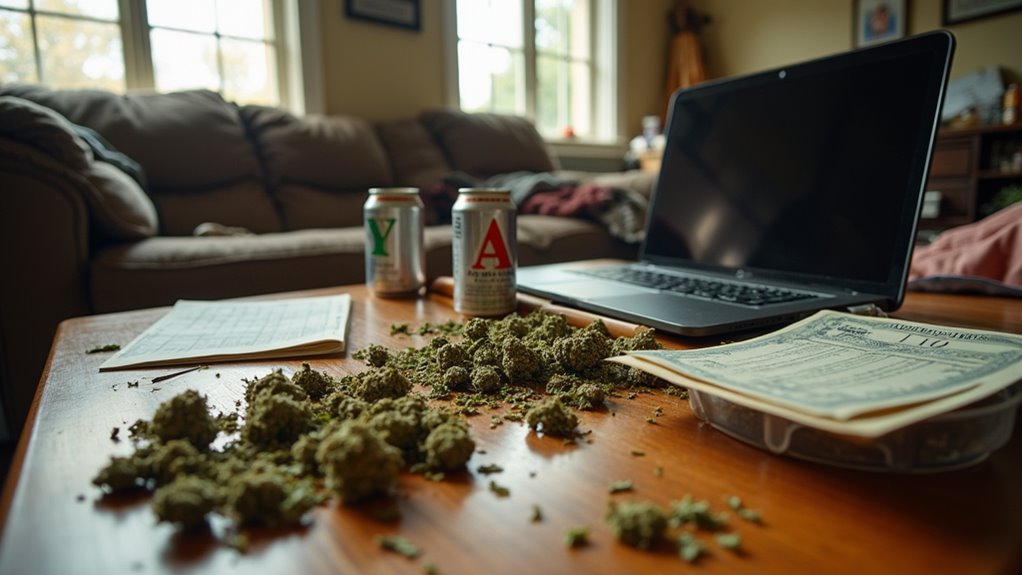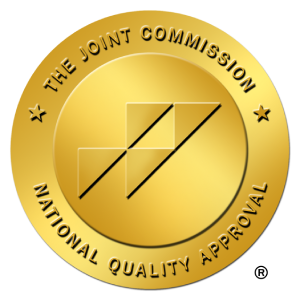To support someone struggling with cannabis addiction, create a safe space for open communication while maintaining clear boundaries. Listen actively without judgment, validate their experiences, and encourage them to seek professional help through therapy or support groups. You’ll need to recognize signs of dependency like increased tolerance and mood changes, while practicing self-care to avoid burnout. Understanding the complex nature of addiction and available treatment options will strengthen your ability to provide meaningful support.
Understanding the Signs of Cannabis Dependency

While many people can use cannabis recreationally without developing dependency, recognizing the signs of addiction is crucial for helping someone who’s struggling. You’ll want to watch for physical indicators like bloodshot eyes, rapid heart rate, and coordination issues, along with psychological changes including increased anxiety, memory problems, and mood swings. Irregular sleep cycles and excessive drowsiness are also common warning signs to monitor. Users may experience short-term memory loss that affects their daily functioning.
When tracking withdrawal symptoms, note if they’re using larger amounts to achieve the same effects or experiencing irritability when unable to use. Start monitoring behavioral changes such as declining performance at work or school, withdrawal from social activities, and growing secrecy about their use. Pay attention if they start spending time with new drug users as this is a common sign of developing marijuana abuse. You might also notice them neglecting personal responsibilities, showing less interest in hobbies, or displaying patterns of relapse after attempting to quit.
Creating a Safe Space for Open Communication

When supporting someone with cannabis use disorder, you’ll need to create an environment where they feel comfortable sharing their experiences without fear of criticism or shame.
Active listening plays a vital role in building trust with the person struggling with addiction.
You can demonstrate your commitment to understanding their perspective by maintaining eye contact, nodding attentively, and using person-first language that acknowledges their humanity rather than defining them by their substance use. Consider positioning yourself at the same height level as them since sitting together can help establish trust and rapport.
Listen Without Judgment
Creating a safe space for open communication begins with mastering the art of judgment-free listening. To avoid a paternalistic approach, focus on reflecting the speaker’s statements and asking open-ended questions that encourage deeper exploration of their feelings. Being aware of emotional manipulation tactics can help you maintain healthy boundaries while still providing support. When you make positive affirmations, it strengthens your relationship and encourages continued progress. Prioritize a non-judgmental mindset by maintaining steady eye contact and removing distractions during conversations.
When your loved one speaks, resist the impulse to interrupt or provide immediate remedies. Instead, use gentle nodding and supportive body language to demonstrate your engagement. Pause before responding to prevent reactive comments, and validate their emotional experiences by acknowledging their struggles as legitimate. Most people tend to focus on crafting their response rather than truly listening to what’s being said. Keep in mind that effective listening isn’t about resolving issues but establishing a space where they feel safe enough to express themselves honestly and navigate their cannabis challenges.
Building Trust Through Empathy
True empathy forms the bedrock of supporting someone through cannabis addiction recovery. By empathizing with past struggles and emphasizing consistency in support, you’ll create a foundation of trust that’s essential for healing. Show understanding by validating their experiences and normalizing feelings of shame or guilt that often accompany addiction. Taking time to learn about addiction through programs like Al-Anon support groups can help you better understand their challenges. Practice active listening skills to demonstrate genuine engagement and understanding during conversations. Understanding that addiction causes brain structure changes helps maintain patience and compassion throughout the recovery journey.
| Action | Purpose | Impact |
|---|---|---|
| Validate emotions | Shows understanding | Cultivates safety |
| Celebrate progress | Reinforces growth | Augments confidence |
| Maintain boundaries | Provides structure | Preserves stability |
Remember to acknowledge withdrawal symptoms as legitimate challenges while framing setbacks as opportunities for learning. Your unwavering support, regardless of recovery milestones, demonstrates genuine care and understanding. Focus on creating a judgment-free environment where they can openly discuss cravings, triggers, and fears without hesitation.
Setting Healthy Boundaries While Offering Support

Supporting someone with cannabis addiction requires establishing clear, healthy boundaries that protect both parties while maintaining a compassionate connection. You’ll need to find the balance between showing care and cultivating accountability without enabling destructive behaviors.
Start by clearly communicating your expectations using “I” statements and enforce consistent consequences for boundary violations. Setting boundaries helps promote self-discovery and growth in the recovery journey. Don’t provide financial support for cannabis purchases or offer legal bailouts that perpetuate the cycle of addiction. Set limits on interactions during periods of intoxication and maintain your personal space as a substance-free zone. Understanding that personal values and needs must guide your boundaries will help you stay consistent in your support approach. Remember that boundaries are a decision, not an ultimatum when working to help someone overcome addiction.
When traversing codependency, remember to prioritize your emotional well-being through self-care routines and support networks. Stay firm with your boundaries even when faced with resistance, but maintain an empathetic approach that leaves the door open for meaningful connection when they’re ready for change.
Essential Resources and Treatment Options
Once you’ve established healthy boundaries, understanding the available treatment scenery can drastically improve your capability to direct someone in the direction of recovery. Treatment options range from evidence-based therapies like CBT and MET to community-based programs that offer peer support and counseling services.
For inclusive care, many facilities provide medication monitoring through off-label medications or symptom management while addressing both physical and mental health needs. Some individuals benefit from intensive outpatient programs, while others may require residential treatment, especially in complex cases involving multiple disorders. Given that withdrawal symptoms often include irritability and sleeping problems, medical supervision during the initial recovery phase can be crucial.
The key is finding the right combination of support services that match your loved one’s specific needs and circumstances. Consider factors like insurance coverage, location accessibility, and program flexibility when exploring treatment options together.
Effective Strategies for Preventing Relapse
Understanding your personal triggers is the initial vital step in preventing cannabis relapse, whether they’re emotional stressors, specific locations, or challenging social situations.
You’ll strengthen your recovery by establishing consistent daily routines that include exercise, proper nutrition, and activities that bring you joy and purpose. Building and maintaining strong connections with supportive friends, family members, and recovery groups will provide you with indispensable accountability and encouragement when facing difficult moments.
Identify Personal Trigger Points
Identifying personal trigger points marks a critical step in helping someone overcome cannabis addiction, as these triggers often act as catalysts for relapse. You’ll need to help them recognize internal influences like stress, anxiety, and low self-esteem, while also working to mitigate external pressures such as social environments where cannabis use occurs.
Encourage them to document both their emotional states and situational factors that intensify cravings. Watch for signs of underlying mental health challenges, such as depression or anxiety disorders, that might complicate their recovery path. Pay special attention to lifestyle elements that could increase vulnerability, including isolation, work-related stress, or unresolved relationship conflicts. By understanding these personal triggers, you’ll be better equipped to help them develop targeted coping strategies and avoid high-risk situations.
Build Daily Healthy Routines
Building daily healthy routines serves as a cornerstone in preventing cannabis relapse, as it helps create stability and purpose during recovery. Through organized time management and consistent daily rituals, you’ll establish a framework that supports long-term sobriety.
| Time of Day | Essential Activities | Benefits |
|---|---|---|
| Morning | Meditation & Exercise | Mental clarity, reduced anxiety |
| Mid-Morning | Balanced Meal & Hydration | Stable energy, improved mood |
| Afternoon | Productive Work/Hobbies | Purpose, reduced boredom |
| Evening | Social Connection/Learning | Support system strength |
| Night | Sleep Hygiene Practice | Recovery, stress reduction |
Help your loved one implement these routines gradually, starting with small, manageable changes. Encourage them to track their progress using apps or journals, and celebrate their commitment to these healthy habits. Recall that flexibility within structure allows for sustainable lifestyle changes while maintaining recovery goals.
Create Strong Support Networks
When someone battles cannabis addiction, a strong support network becomes their lifeline to sustained recovery. Encourage them to join peer support groups like Narcotics Anonymous, where they’ll connect with others who understand their struggles and can share valuable recovery insights.
Help them establish sober social circles by introducing them to people who prioritize healthy, substance-free lifestyles. Offer practical assistance, such as rides to therapy sessions or help with daily tasks, to reduce stress and maintain their focus on recovery. Stay connected through regular, non-judgmental check-ins and encourage open communication about their challenges.
Remember to combine these social support strategies with professional help, such as cognitive-behavioral therapy and counseling. A well-rounded support system that includes both peer relationships and therapeutic interventions greatly increases their chances of long-term recovery success.
Building a Strong Support Network
A strong support network serves as an indispensable foundation for anyone overcoming cannabis addiction. By forming recovery-focused communities, you’ll create connections with others who understand the challenges of breaking free from marijuana dependency. Consider suggesting groups like Marijuana Anonymous, where they can find peers committed to sobriety and healing.
Help your loved one maintain positive peer influences by encouraging them to distance themselves from drug-centric social circles, as nearly 24 million Americans currently use cannabis, creating significant social pressure. Instead, guide them toward therapeutic communities and sober activities that minimize exposure to triggers.
Keep in mind that reducing stigma is vital many avoid treatment due to societal perceptions, so create an environment where they feel safe discussing their struggles and seeking professional help.
Managing Crisis Situations and Emergencies
Recognizing and responding to crisis situations requires swift, informed action when helping someone with cannabis addiction. If your loved one shows signs of psychosis, severe withdrawal, or suicidal thoughts, don’t hesitate to call emergency services or the SAMHSA National Helpline for immediate support.
Protocol-driven interventions through emergency departments ensure proper assessment and stabilization. You’ll want to advocate for warm handoffs to long-term treatment programs and support your loved one through the move.
For overdose risk mitigation, especially in cases of polysubstance use, be aware that emergency rooms provide naloxone and other life-saving interventions.
Remember to document any concerning behaviors, including impaired driving incidents or legal issues, as these details can help healthcare providers develop more effective treatment plans and crisis prevention strategies.
Self-Care Tips for Support Providers
Supporting someone with cannabis addiction can take a significant toll on your mental and emotional well-being. While fostering self-compassion, prioritize your health by engaging in regular exercise, mindfulness practices, and personal hobbies. Maintaining emotional balance requires setting clear boundaries and protecting your energy.
| Self-Care Focus | Why It Matters | Action Steps |
|---|---|---|
| Physical Health | Reduces stress | Daily exercise, yoga |
| Mental Balance | Prevents burnout | Meditation, journaling |
| Social Support | Shares the load | Join support groups |
| Professional Help | Guarantees sustainability | Regular therapy sessions |
Remember to stay informed about CUD through credible sources while building your support network. Connect with other caregivers through support groups and don’t hesitate to seek professional guidance when needed. Your well-being is essential for providing sustainable support to your loved one.
Frequently Asked Questions
How Long Does Cannabis Stay Detectable in Drug Tests?
Cannabis detection windows vary markedly based on the testing method used. In urine screening methods, you’ll find it detectable for 3-30+ days, depending on usage frequency.
Blood tests can show recent use for 2-12 hours, while saliva tests detect use within 72 hours. Hair tests offer the longest detection window estimates, up to 90 days. Keep in mind that individual factors like metabolism, hydration, and usage patterns affect these timeframes.
Can Secondhand Cannabis Smoke Affect Drug Test Results?
While passive cannabis exposure through secondhand smoke can technically result in THC detection, you’re unlikely to fail a standard drug test from casual exposure. The secondhand smoke composition typically doesn’t deliver enough THC to exceed testing thresholds.
However, you’ll want to avoid prolonged exposure in poorly ventilated spaces, as extreme conditions could potentially lead to detectable levels. For peace of mind, it’s best to avoid enclosed spaces where cannabis is being smoked.
What Medications Can Help Manage Cannabis Withdrawal Symptoms?
Several medications can help manage cannabis withdrawal symptoms. For anxiety, your doctor may prescribe gabapentin or bupropion to ease restlessness and irritability.
If you’re experiencing sleep disturbances, medications like quetiapine or mirtazapine can help regulate your sleep patterns. Naltrexone may reduce cravings, while dronabinol can ease general withdrawal discomfort.
Always work with a healthcare provider to determine the most appropriate medication plan, as everyone’s needs differ.
Does Health Insurance Typically Cover Cannabis Addiction Treatment Programs?
Yes, most health insurance plans cover cannabis addiction treatment costs due to federal requirements. You’ll typically find coverage for both outpatient and inpatient programs under substance use disorder benefits.
However, coverage details vary by plan you may need prior authorization, and there could be network restrictions or copays. It’s best to contact your insurance provider directly to understand your specific benefits and any out-of-pocket expenses for treatment programs.
How Can I Distinguish Recreational Use From Problematic Cannabis Dependency?
You can spot signs of problematic use when cannabis consumption begins interfering with your daily life. While recreational users maintain control over their usage and responsibilities, dependency often shows up as neglecting work or relationships, needing more cannabis to feel the same effects, and experiencing withdrawal symptoms when not using.
If you’re spending significant time thinking about, using, or recovering from cannabis use, these could indicate a shift from recreational to problematic use.






